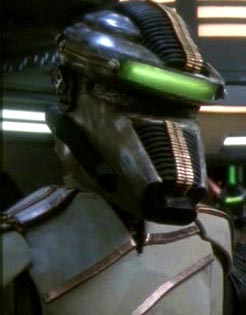Portrait of a Character – Gina Nolan
Gina Nolan is more than a widow.
Origins
As the tenth anniversary of 9/11 came closer, I found myself thinking about that day. I wanted, in particular, to write about women who had been pregnant at the time of the attack. The Breen attack on Earth seemed a good backdrop for that. Plus it was a chance to learn about a part of Star Trek that I really didn’t know anything about. Therefore, I began with a story of a pregnant woman, and framed it against Elizabeth Kubler-Ross’s five stages of grief.
Portrayal

Gina Nolan (Elisabetta Canalis)
Gina is portrayed by Italian actress Elisabetta Canalis, currently best known in the United States for dating George Clooney.
Personality
Brassy and no-nonsense, Gina becomes a widow. This is when her husband Michael, a Xenobotanist, is instantly killed at his Beijing laboratory. She has been at home on Proxima Centauri, safe from the attack, but bereft all the same. Most of her story is told in Hold Your Dominion, although a portion is told in Wider Than the Sargasso Sea.
The Five Stages of Grief
Denial
Keeping away the soldiers tasked with informing her of the death seems her only logical move. Of course that doesn’t bring Michael back; it just prolongs the moment of learning of his death.
Anger
On Andoria for a memorial service, Gina loses patience with just about everyone.
Bargaining
To get across the idea of bargaining, I had her haggle with a Ferengi merchant. Still on Andoria, and still run ragged, she gets redbat at a decent price. This is particularly after a security officer intervenes.
Depression
Returning to Proxima, smells and rudeness overcome Gina Nolan. But it all comes to a head when she sees the destroyed tree in her front yard. A symbol of her and Michael’s love, it was killed when a military shuttle landed on it and its inhabitants told her of her husband’s death. It’s all too much for her, and she spirals downwards.
Acceptance
She spends her first Christmas after Michael’s death with her parents. She takes them to a crossing of streets now named Michael Nolan Square. A dedication plaque reads, “This square is dedicated to Xenobotanist Michael G. Nolan, born July first, 2341. Nolan died on October tenth, 2375, at his lab in Beijing, when the Breen attacked Earth. He left a wife and a daughter.”
Aftermath
Healing
Five years after the attack, someone pulls Gina Nolan along to look at artwork. Whose artwork? Her daughter’s. The children at Decker Elementary have all drawn something about the Breen attack. While there, they spot a lost child. She’s a little Klingon girl who is a bit older than Gina’s daughter, Gabrielle. The girl, Freela, is crying for her father. When they are back together, there is a ribbon award for the best drawing in the first grade. It goes to Freela. Gina suggests ice cream, and Freela’s father, Kittris, agrees.
Ice Cream
As the grownups talk and the girls play, it becomes apparent that there might be a chance for something more than just a pleasant afternoon.
Rituals
Ten years later, a milestone in Kittriss’s family is an occasion for Gina Nolan and Gabby to again try to fit in.
Good-bye
Five years afterwards, Gina is part of an interview for a commemoration of the attack. She remembers Michael, but not with sadness.
The Next Generation
In Wider Than the Sargasso Sea, much of the action shifts to Gabrielle. But Gina is still there, still fighting, and is a part of a large crowd protesting Breen moving into their neighborhood and, as that story begins, yells, “Breen, go home!”
Relationships
Michael Nolan
I never show him alive, although I might write a flashback at some point. Their marriage was a decent one, but they worked on different planets, and that could not have been easy.
Kittriss
Originally, shared grief draws them together. But then it becomes something more. Together, they raise their daughters – and I often (albeit not actually in my fan fiction) refer to them as “The Klingon Brady Bunch”.
Mirror Universe

Mirror Gina Nolan
In the Mirror Universe, Gina is a Captain’s Woman, to Alexander Bashir (In The Point is Probably Moot he’s the captain of the ISS Molotov). But she does have a taste for Klingon men, and meets Kittress under very different circumstances, in Smash Your Dominion.
Quote
“It wasn’t meant to be fair, and that’s not just because of the Breen. It’s, in general. (so) It’s never meant to be fair. It’s death, and while I think it holds account books, I also don’t kid myself. (so) It’s not a simple equation. It’s not like we gathered all the bad people together, and then told the Breen to have at it. (so) It’s not that. And it’s not God taking the most righteous or that kind of bull, either. It was just a bunch of people who drew the unlucky card that day. If I didn’t have my teaching job here, I would have been living in Beijing, too. And then Gabrielle and I would be gone, too.”
Upshot
I think the Sargasso Sea story mainly wrapped up this story line. But I don’t know. Gina Nolan often surprises me, and she may yet do so again.



